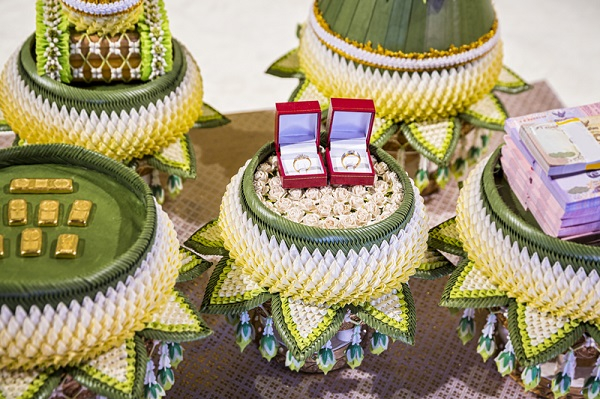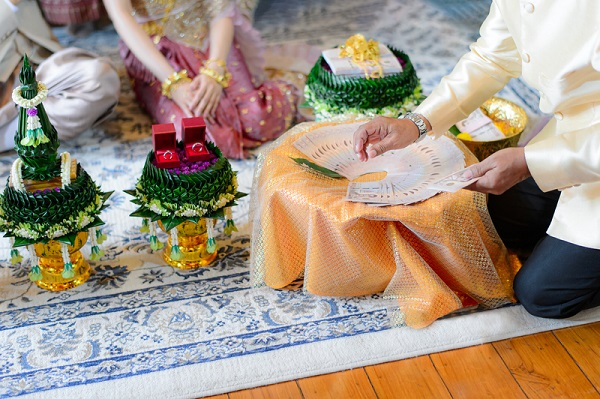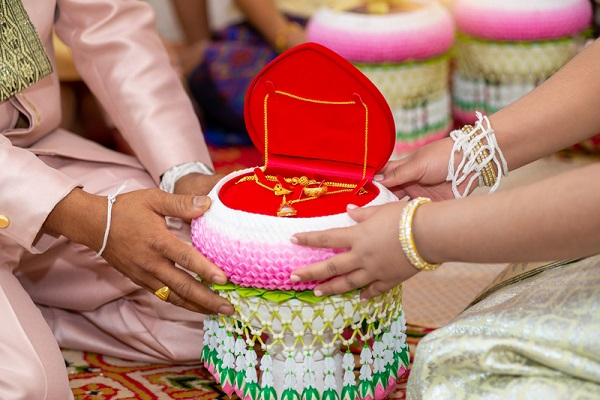

Marriage payments, also known as bride wealth or dowry, are payments made by one party (usually the groom or his family) to the other party (usually the bride or her family) as a condition of marriage. These payments can take various forms, such as cash, property, or goods, and serve different purposes depending on the cultural context.

"Bridewealth" is the payment made by the groom or his family to the bride or her family in exchange for the bride's hand in marriage. Dowry is the payment made by the bride or her family to the groom or his family as a condition of marriage. These payments have been studied by anthropologists, economists, sociologists, and legal scholars, among others. The practice of bridewealth and dowry is prevalent in many parts of the world, but the specific customs and traditions surrounding these payments can vary significantly from one culture to another.

Figure : Money given as dowry in a marriage.
Cash − A cash payment is the most common form of marriage payment and is used to compensate the bride's family for the loss of a family member and/or as a way of securing alliances between families.
Property − Property payments are less common but can be an important form of marriage payment in societies where land is a valuable resource. Property payments can take the form of land, houses, or other valuable assets, and can serve both to compensate the bride's family and to establish a home for the newlyweds.
Goods − Goods are also a form of marriage payment, especially in societies where bride wealth, or dowry, is traditionally not in cash or property but in goods such as textiles, jewellery, or livestock. These goods can serve as compensation for the bride's family as well as serve a symbolic purpose in the marriage.
Services − Services as a form of payment is less common, it could be for example if the groom has a specific set of skills like in construction or farming could be used as a form of payment.

Bride wealth: payments made by the groom or his family to the bride or her family in exchange for the bride's hand in marriage
Dowry: payments made by the bride or her family to the groom or his family as a condition of marriage
Vary widely in terms of amount, form, and purpose depending on the cultural context
Can include cash, property, goods, or a combination of these
In some societies, bride wealth and dowry may be viewed as separate payments with distinct meanings and functions
Can be formal or informal, contractual or non-contractual, and may or may not be legally enforceable.
May be paid in a single lump sum or in multiple instalments.
Used to support brides, build social capital, and secure alliances
Cultural and societal norms − The customs and traditions surrounding marriage payments, including the specific forms they take and the reasons they are given, are heavily influenced by cultural and societal norms. For example, in some cultures, the primary purpose of bride wealth is to ensure that the bride's family is economically compensated for losing a member, while in other cultures, it may be seen as a way to secure alliances between families.
Economic factors − Wealth, income, and social status can play a significant role in determining the amount and form of marriage payments. For example, in societies where wealth is concentrated among a small elite, bride wealth and dowry payments may be larger and more elaborate, while in societies where wealth is more evenly distributed, they may be more modest.
Political and legal factors − Laws and policies governing marriage and property rights can also influence the nature of marriage payments. For example, in societies where women have more legal rights and control over property, the practice of dowry may be less prevalent or may take a different form.
Religious and familial customs − Religion and familial customs can also shape the practice of marriage payments. For example, in societies where marriage is considered a religious sacrament, religious leaders may play a key role in negotiating marriage payments, and the payments themselves may be seen as a way to fulfill religious obligations.
Education, modernization, and social trends − As societies become more educated and modernized, social trends and norms can also change, affecting the practice of marriage payments. For example, in societies where women are more highly educated, the concept of bride wealth and dowry may not be as important or prevalent.
In conclusion, bride wealth and dowry systems are complex and multifaceted, influenced by a variety of cultural, societal, economic, political, religious, and familial factors. These payments can take various forms, such as cash, property, or goods, and serve different purposes depending on the cultural context. Understanding the characteristics and factors that influence these systems is important for understanding the role of marriage payments in different cultures and societies.
Q1: Are bride wealth and dowry synonymous?
Ans: No, they are different payments with distinct meanings and functions. Bride wealth refers to payments made by the groom or his family to the bride or her family in exchange for the bride's hand in marriage, while dowry refers to payments made by the bride or her family to the groom or his family as a condition of marriage.
Q2: What are the factors that influence bride wealth and dowry systems around the world?
Ans: Cultural and societal norms; economic factors, such as wealth, income, and social status; political and legal factors, such as laws and policies governing marriage and property rights; religious and familial customs; and education, modernization, and social trends are some of the factors that influence bride wealth and dowry systems around the world
Q3: Is the bride's wealth or dowry legally enforceable?
Ans: It can vary depending on the cultural and legal context. In some societies, these payments may be legally enforceable, while in others they may be considered informal or non-contractual.